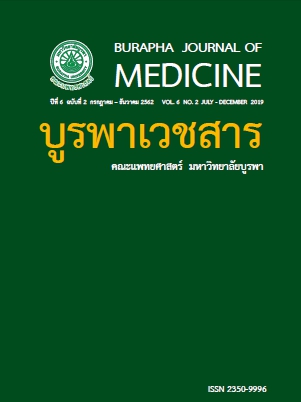ปัจจัยเสี่ยงและลักษณะทางคลินิกของ ภาวะเลือดออกทางเดินอาหารส่วนต้นจาก เส้นเลือดโป่งพองและไม่ใช่เส้นเลือดโป่งพอง
คำสำคัญ:
เลือดออกทางเดินอาหารส่วนต้น, เส้นเลือดโป่งพอง, ไม่ใช่เส้นเลือดโป่งพองบทคัดย่อ
บทนำ ภาวะเลือดออกทางเดินอาหารส่วนต้นเป็นภาวะฉุกเฉินที่พบบ่อย และมีอัตราการเสียชีวิตสูง จำเป็นต้อง
ให้การรักษาอย่างถูกต้องและรวดเร็ว
วัตถุประสงค์ เพื่อหาปัจจัยเสี่ยงที่สัมพันธ์กับภาวะเลือดออกทางเดินอาหารส่วนต้นจากเส้นเลือดโป่งพองและ
ไม่ใช่สาเหตุจากเส้นเลือดโป่งพอง
วิธีการศึกษา เป็นการศึกษาแบบย้อนหลัง ในผู้ป่วยโรงพยาบาลสมเด็จพระเจ้าตากสินมหาราชที่ได้รับการวินิจฉัย
ภาวะเลือดออกทางเดินอาหารส่วนต้น เป็นระยะเวลา 1 ปี โดยศึกษาจากประวัติทางการแพทย์ อาการ อาการ
แสดง และผลการตรวจทางห้องปฏิบัติการแล้วนำมาวิเคราะห์
ผลการศึกษา กลุ่มตัวอย่าง 171 คน เป็นสาเหตุจากเส้นเลือดโป่งพอง ร้อยละ 12.8 ไม่ใช่สาเหตุจากเส้นเลือด
โป่งพอง ร้อยละ 87.2 ปัจจัยเสี่ยงที่สัมพันธ์กับสาเหตุเส้นเลือดโป่งพอง ได้แก่ ประวัติการดื่มแอลกอฮอล์ ประวัติ
เลือดออกทางเดินอาหารส่วนต้นจากสาเหตุเส้นเลือดโป่งพอง อาเจียนเป็นเลือด การสวนล้างกระเพาะอาหารผ่าน
สายสวนทางจมูกแล้วได้เป็นเลือดสด ความดันโลหิตต่ำ ตับแข็ง ท้องมาน เกล็ดเลือดต่ำ ระดับ AST, ALT, total
bilirubin สูง และ อัตราส่วน albumin ต่อ globulin ต่ำ และกลุ่มที่ไม่ใช่เส้นเลือดโป่งพอง ได้แก่ ประวัติการ
ใช้ยาแก้อักเสบที่ไม่ใช่สเตียรอยด์ และยาต้านเกล็ดเลือด
สรุป ข้อค้นพบใหม่ของการศึกษานี้คือ ปัจจัยประวัติการใช้ยาแก้อักเสบที่ไม่ใช่สเตียรอยด์ และ อัตราส่วน
albumin ต่อ globulin ต่ำที่สามารถใช้แยกสาเหตุของภาวะเลือดออกทางเดินอาหารส่วนต้น และช่วยให้ผู้
ป่วยได้รับการรักษาอย่างเหมาะสม
เอกสารอ้างอิง
demographics of upper gastrointestinal
bleeding: prevalence, incidence, and
mortality. Gastrointest Endosc Clin N Am.
2011; 21: 567-81.
2. Van Leerdam ME. Epidemiology of acute
upper gastrointestinal bleeding. Best Pract
Res Clin Gastroenterol. 2008; 22: 209-24.
3. สมาคมแพทย์ส่องกล้องทางเดินอาหารไทย.
แนวทางการดูแลรักษาผู้ป่วยที่มาด้วยภาวะเลือด
ออกในทางเดินอาหารส่วนต้นในประเทศไทย.
กรุงเทพฯ: สมาคมแพทย์ส่องกล้องทางเดินอาหาร
ไทย. 2557.
4. Van Leerdam ME, Vreeburg EM, Rauws
EA. Acute upper GI bleeding: did anything
change? Time trend analysis of incidence
and outcome of acute upper GI bleeding
between 1993/1994 and 2000. Am J
Gastroenterol. 2003; 98: 1494-9.
5. Barkun AN, et al; International Consensus
Upper Gastrointestinal Bleeding
Conference Group. Ann Intern Med. 2010;
152: 101-13.
6. Barkun A, Bardou M, Marshall JK.
Nonvariceal Upper GI Bleeding Consensus
Conference Group. Ann Intern Med. 2003;
139: 843-57.
7. Sung JJ, Chan FK, Chen M. Asia-Pacific
Working Group consensus on non-variceal
upper gastrointestinal bleeding. Gut. 2011;
60: 1170-7.
8. Hwang JH, Fisher DA, Ben-Menachem T.
The role of endoscopy in the management
of acute non-variceal upper GI bleeding.
Gastrointest Endosc. 2012; 75: 1132-38.
9. Biecker E. Portal hypertension and
gastrointestinal bleeding: diagnosis,
prevention and management. World J
Gastroenterol. 2013; 19: 5035-50.
10. Garcia-Tsao G, Sanyal AJ, Grace ND,
Carey W. Prevention and management
of gastroesophageal varices and variceal
hemorrhage in cirrhosis. Hepatology. 2007;
46: 922-38.
11. Sarin SK, Kumar A, Angus PW. Asian
Pacific Association for the study of the
Liver (APASL) Working Party on Portal
Hypertension. Diagnosis and management
of acute variceal bleeding: Asian Pacific
Association for Study of the Liver
recommendations. Hepatol Int. 2011; 5:
607-24.
12. Levacher S, Letoumelin P, Pateron
D, Blaise M, Lapandry C, PourriatJL.
Early administration of terlipressin plus
glyceryl trinitrate to control active upper
gastrointestinal bleeding in cirrhotic
patients. Lancet. 1995; 346: 865-8.
13. Opio CK, Garcia-Tsao G. Managing varices:
drugs, bands, and shunts. Gastroenterol
Clin North Am. 2011; 40: 561-79.
14. De Franchis R. Evolving consensus in portal
hypertension. Report of the Baveno IV
consensus workshop on methodology
of diagnosis and therapy in portal
hypertension. J Hepatol. 2005; 43: 167-76.
15. Kim SY, Hyun JJ, Jung SW, Lee SW.
Management of non-variceal upper
gastrointestinal bleeding. Clin Endosc.
2012; 45: 220-23.
16. Holster IL, Kuipers EJ. Management of
acute nonvariceal upper gastrointestinal
bleeding: current policies and future
perspectives. World J Gastroenterol. 2012;
18: 1202-7.
17. Sreedharan A, Martin J, Leontiadis GI.
Proton pump inhibitor treatment initiated
prior to endoscopic diagnosis in upper
gastrointestinal bleeding. Cochrane
Database Syst Rev. 2010; 7: 5415.
18. Matei D, Groza I, Furnea B, Puie L, Levi C,
Chiru A. Predictors of Variceal or Nonvariceal
Source of Upper gastrointestinal bleeding.
An etiology predictive score established
and validated in a tertiary referral center.
J Gastrointestin Liver Dis. 2013; 22: 379-84
19. Pongprasobchai S, Nimitvilai S, Chasawat
J, Manatsathit S. Uppergastrointestinal
bleeding etiology score for predicting
variceal and non-variceal bleeding. World
J Gastroenterol. 2009; 15: 1099-104.
20. Alharbi A, Almadi M, Barkun A, Martel
M, REASON Investigators.Predictors of a
variceal source among patients presenting
with upper gastrointestinal bleeding. Can
J Gastroenterol. 2012; 26: 187-92.
21. Rattanasupar A. Role of clinical parameters
for predicting the cause of upper
gastrointestinal bleeding. J Med Assoc
Thai. 2012; 95: 22-8.
22. Lahiffa C, Shieldsa W, Cretua I, Mahmuda
S, McKiernana S, Norrisa S,et al. Upper
gastrointestinal bleeding: predictors of
risk in a mixed patient group including
variceal and nonvariceal haemorrhage.
EUR J GASTROEN HEPAT. 2012; 24: 149-54.
23. Zuidema G. In Shackelford’s Surgery of the
Alimentary Tract, 4th ed. Philadelphia: WB
Saunders. 1995.
24. พนิดา ทองอุทัยศร. Patients with abnormal
liver function test. [อินเตอร์เน็ต]. เข้าถึงเมื่อ:
15 มี.ค. 2562. เข้าถึงได้จาก https://med.
mahidol.ac.th.



